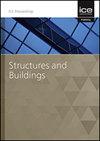Assembly process based on supply chain management of prefabricated houses using building information modeling
IF 1.4
4区 工程技术
Q3 CONSTRUCTION & BUILDING TECHNOLOGY
Proceedings of the Institution of Civil Engineers-Structures and Buildings
Pub Date : 2022-11-29
DOI:10.1680/jstbu.22.00153
引用次数: 1
Abstract
The paper analyzes the assembly process by the example of assembly-modular containers using building information modeling technologies. This paper simulates a 3D model of the Huoshenshan Hospital with a description of the assembly mechanism process based on information modeling of prefabricated buildings. The purpose of this paper is to analyze the sources on prefabricated houses and explore the concept of creating a digital prototype of a building based on Huoshenshan Hospital, using the Autodesk Revit software. The article describes the methodology of installing modular containers and assembly structures using building information modeling technologies to improve rapid construction technology. The study results showed that building object implementation directly depends on a proper model with a step-by-step mechanism for installation, which can reduce the initial project cost due to the supply of prefabricated structures on the construction site, as well as reduce the project time. The prefabricated house technology demonstrated the high efficiency of using information technology in the assembly of the Huoshenshan Hospital, with which the simulated facility was implemented in 10 days. The need for information modeling data exchange with modern gadgets and systems is investigated, which allows one to get acquainted with the object at the construction site before installation work start.基于建筑信息模型的装配式房屋供应链管理
本文以装配模块化集装箱为例,运用建筑信息建模技术对装配过程进行了分析。本文基于装配式建筑的信息建模,对火神山医院的三维模型进行了仿真,描述了装配式建筑的装配机理过程。本文的目的是分析装配式房屋的来源,并探讨以火神山医院为例,利用Autodesk Revit软件创建建筑数字原型的概念。本文描述了使用建筑信息建模技术安装模块化集装箱和装配式结构的方法,以改进快速施工技术。研究结果表明,建筑对象的实现直接依赖于一个合适的模型和一个循序渐进的安装机制,这可以减少由于预制结构在施工现场供应的初始项目成本,并减少项目时间。装配式房屋技术展示了信息技术在火神山医院装配中的高效率,模拟设施在10天内实施。研究了与现代设备和系统进行信息建模数据交换的需求,使人们能够在安装工作开始之前熟悉施工现场的对象。
本文章由计算机程序翻译,如有差异,请以英文原文为准。
求助全文
约1分钟内获得全文
求助全文
来源期刊
CiteScore
3.40
自引率
6.20%
发文量
61
审稿时长
12 months
期刊介绍:
Structures and Buildings publishes peer-reviewed papers on the design and construction of civil engineering structures and the applied research associated with such activities. Topics include the design, strength, durability and behaviour of structural components and systems.
Topics covered: energy conservation, people movement within and around buildings, strength and durability of steel and concrete structural components, and the behaviour of building and bridge components and systems

 求助内容:
求助内容: 应助结果提醒方式:
应助结果提醒方式:


